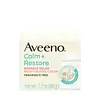What's inside
What's inside
 Key Ingredients
Key Ingredients

No key ingredients
 Benefits
Benefits

 Concerns
Concerns

 Ingredients Side-by-side
Ingredients Side-by-side

Water
Skin ConditioningGlycerin
HumectantC12-15 Alkyl Benzoate
AntimicrobialCetearyl Alcohol
EmollientDimethicone
EmollientArachidyl Alcohol
EmollientCetyl Alcohol
EmollientAvena Sativa Kernel Flour
AbrasivePhenyl Trimethicone
Skin ConditioningCetearyl Glucoside
EmulsifyingBehenyl Alcohol
EmollientSodium Polyacrylate
AbsorbentPhenoxyethanol
PreservativePanthenol
Skin ConditioningCaprylyl Glycol
EmollientEthylene/Acrylic Acid Copolymer
Emulsion StabilisingPolyacrylamide
Arachidyl Glucoside
EmulsifyingC13-14 Isoparaffin
EmollientChrysanthemum Parthenium Flower/Leaf/Stem Juice
AntioxidantChlorphenesin
AntimicrobialDisodium EDTA
Pentaerythrityl Tetra-Di-T-Butyl Hydroxyhydrocinnamate
AntioxidantLaureth-7
EmulsifyingCeramide NP
Skin ConditioningWater, Glycerin, C12-15 Alkyl Benzoate, Cetearyl Alcohol, Dimethicone, Arachidyl Alcohol, Cetyl Alcohol, Avena Sativa Kernel Flour, Phenyl Trimethicone, Cetearyl Glucoside, Behenyl Alcohol, Sodium Polyacrylate, Phenoxyethanol, Panthenol, Caprylyl Glycol, Ethylene/Acrylic Acid Copolymer, Polyacrylamide, Arachidyl Glucoside, C13-14 Isoparaffin, Chrysanthemum Parthenium Flower/Leaf/Stem Juice, Chlorphenesin, Disodium EDTA, Pentaerythrityl Tetra-Di-T-Butyl Hydroxyhydrocinnamate, Laureth-7, Ceramide NP
Water
Skin ConditioningGlycerin
HumectantPanthenol
Skin ConditioningCaprylic/Capric Triglyceride
MaskingDicaprylyl Carbonate
EmollientOctyldodecanol
EmollientC12-15 Alkyl Benzoate
AntimicrobialDimethicone
EmollientSqualane
EmollientTapioca Starch
Cetearyl Alcohol
EmollientGlyceryl Stearate Citrate
EmollientMyristyl Myristate
EmollientButylene Glycol
HumectantBenzyl Alcohol
PerfumingGlycyrrhiza Inflata Root Extract
Skin ConditioningCarbomer
Emulsion StabilisingPhenoxyethanol
PreservativeAmmonium Acryloyldimethyltaurate/Vp Copolymer
Sodium Hydroxide
BufferingMethylparaben
PreservativePropylparaben
PreservativeIodopropynyl Butylcarbamate
PreservativeWater, Glycerin, Panthenol, Caprylic/Capric Triglyceride, Dicaprylyl Carbonate, Octyldodecanol, C12-15 Alkyl Benzoate, Dimethicone, Squalane, Tapioca Starch, Cetearyl Alcohol, Glyceryl Stearate Citrate, Myristyl Myristate, Butylene Glycol, Benzyl Alcohol, Glycyrrhiza Inflata Root Extract, Carbomer, Phenoxyethanol, Ammonium Acryloyldimethyltaurate/Vp Copolymer, Sodium Hydroxide, Methylparaben, Propylparaben, Iodopropynyl Butylcarbamate
 Reviews
Reviews

Ingredients Explained
These ingredients are found in both products.
Ingredients higher up in an ingredient list are typically present in a larger amount.
C12-15 Alkyl Benzoate is made up of Benzoic Acid and long chain alcohols. It has a low molecular weight.
C12-15 Alkyl Benzoate is an emollient and texture enhancer. Due to its solubility, it is often used in sunscreens to help evenly distribute active ingredients.
As an emollient, C12-15 Alkyl Benzoate helps soften and hydrate your skin. Emollients create a film on your skin that traps moisture within.
This ingredient has been reported to cause eye irritation.
Learn more about C12-15 Alkyl BenzoateCetearyl alcohol is a mixture of two fatty alcohols: cetyl alcohol and stearyl alcohol. It is mainly used as an emulsifier. Emulsifiers help prevent the separation of oils and products. Due to its composition, it can also be used to thicken a product or help create foam.
Cetearyl alcohol is an emollient. Emollients help soothe and hydrate the skin by trapping moisture.
Studies show Cetearyl alcohol is non-toxic and non-irritating. The FDA allows products labeled "alcohol-free" to have fatty alcohols.
This ingredient is usually derived from plant oils such as palm, vegetable, or coconut oils. There is debate on whether this ingredient will cause acne.
Due to the fatty acid base, this ingredient may not be Malassezia folliculitis safe.
Learn more about Cetearyl AlcoholDimethicone is a type of synthetic silicone created from natural materials such as quartz.
What it does:
Dimethicone comes in different viscosities:
Depending on the viscosity, dimethicone has different properties.
Ingredients lists don't always show which type is used, so we recommend reaching out to the brand if you have questions about the viscosity.
This ingredient is unlikely to cause irritation because it does not get absorbed into skin. However, people with silicone allergies should be careful about using this ingredient.
Note: Dimethicone may contribute to pilling. This is because it is not oil or water soluble, so pilling may occur when layered with products. When mixed with heavy oils in a formula, the outcome is also quite greasy.
Learn more about DimethiconeGlycerin is already naturally found in your skin. It helps moisturize and protect your skin.
A study from 2016 found glycerin to be more effective as a humectant than AHAs and hyaluronic acid.
As a humectant, it helps the skin stay hydrated by pulling moisture to your skin. The low molecular weight of glycerin allows it to pull moisture into the deeper layers of your skin.
Hydrated skin improves your skin barrier; Your skin barrier helps protect against irritants and bacteria.
Glycerin has also been found to have antimicrobial and antiviral properties. Due to these properties, glycerin is often used in wound and burn treatments.
In cosmetics, glycerin is usually derived from plants such as soybean or palm. However, it can also be sourced from animals, such as tallow or animal fat.
This ingredient is organic, colorless, odorless, and non-toxic.
Glycerin is the name for this ingredient in American English. British English uses Glycerol/Glycerine.
Learn more about GlycerinPanthenol is a common ingredient that helps hydrate and soothe the skin. It is found naturally in our skin and hair.
There are two forms of panthenol: D and L.
D-panthenol is also known as dexpanthenol. Most cosmetics use dexpanthenol or a mixture of D and L-panthenol.
Panthenol is famous due to its ability to go deeper into the skin's layers. Using this ingredient has numerous pros (and no cons):
Like hyaluronic acid, panthenol is a humectant. Humectants are able to bind and hold large amounts of water to keep skin hydrated.
This ingredient works well for wound healing. It works by increasing tissue in the wound and helps close open wounds.
Once oxidized, panthenol converts to pantothenic acid. Panthothenic acid is found in all living cells.
This ingredient is also referred to as pro-vitamin B5.
Learn more about PanthenolPhenoxyethanol is a preservative that has germicide, antimicrobial, and aromatic properties. Studies show that phenoxyethanol can prevent microbial growth. By itself, it has a scent that is similar to that of a rose.
It's often used in formulations along with Caprylyl Glycol to preserve the shelf life of products.
Water. It's the most common cosmetic ingredient of all. You'll usually see it at the top of ingredient lists, meaning that it makes up the largest part of the product.
So why is it so popular? Water most often acts as a solvent - this means that it helps dissolve other ingredients into the formulation.
You'll also recognize water as that liquid we all need to stay alive. If you see this, drink a glass of water. Stay hydrated!
Learn more about Water